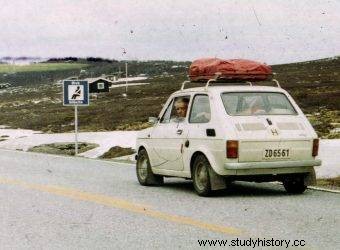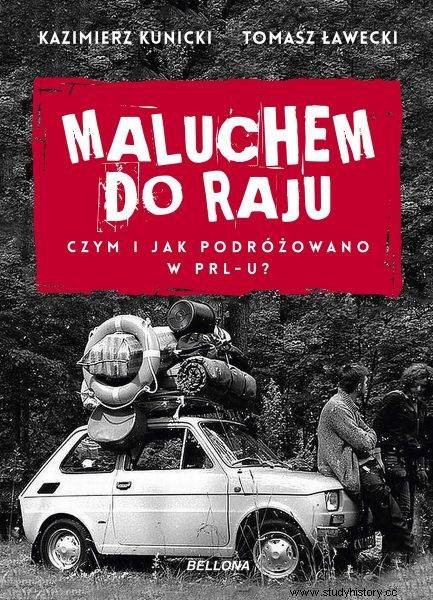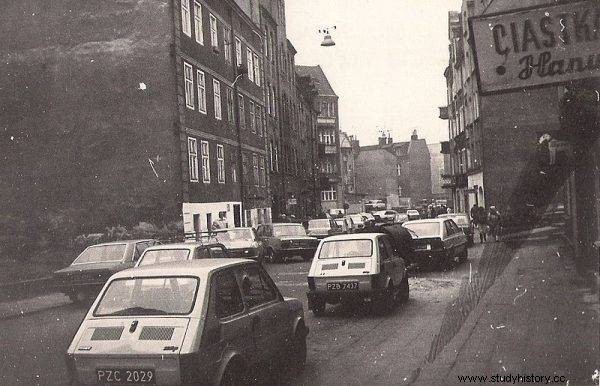Although there were various funny anecdotes about him, he was a dream of many Poles. Passing it on the streets and seeing it in parking lots, one had the impression that it was part of the landscape - until imperceptibly the cult toddler became a museum monument. How was your travels with the popular "cough" and was it possible to travel around the world with it?
The cult Fiat 126p passing along the way evokes some reactions in each of us, brings back memories, and gives rise to sentiment. Who does not know a toddler, as he was affectionately called, a car that, without any casting, unnoticed penetrated into pop culture, as well as into the lives of Polish families.

Owning a Fiat 126 was a dream of many Poles
And although it was supposed to be a car for everyone, it quickly turned out that the prohibitive price of PLN 69,000 at that time was practically impossible to jump for an ordinary Kowalski. The toddler very quickly became a dream of many, and evidence of this can be found in the lyrics of songs, for example by the band Perfect ("Telewizor, furniture, small fiat, / Here is a dream peak") or Izabela Trojanowska ("in eight years / Address in a block and a little fiat, / Don't break your head if you pick it up ").
This, however, did not stop the Poles' appetite for their own four wheels, and even worsened it. And so on June 6, 1973, the first Fiat 126 P rolled off the line and started to conquer Polish hearts, becoming the most recognizable vehicle in our country for many years. There were more and more toddler owners, and with them - anecdotes and more and more sophisticated expressions.

With your toddler you could go on a really long journey - for example to Norway.
Due to the characteristic work of the engine, which also gained recognition among inventive compatriots, the little one was also called a "cough". In the book "Maluszek do Raju", the authors quoted a few jokes that circulated in communist Poland:
When comrade Gierek called to his countrymen:will you help? This event at the rally in the Gdańsk Shipyard was carefully noted all chronicles, including the Polish Film Chronicle. It was the first time and the second? It happened when the first secretary, male of a correct stature, he could not get off the toddler by himself.
Why should a toddler never be painted red? In order not to confuse it with the mailbox.
Why is this the quietest car in the world? Because the driver has so much space that he always covers his ears with his knees.
Why are seat belts installed in this car? To easily turn it into a backpack.
These and other jokes, which still make people smile today, did not deter anyone from buying this small car. On the contrary, sales grew. Perhaps it was caused by the experience of Poles in traveling years ago, incl. a crowded "cucumber". Moving around with your own four wheels was definitely a much better perspective.
Travel small and large
The post-war reality of communist Poland did not offer great travel opportunities. Moving around Poland was limited to leaving the workplace, for example ... mushroom picking:
It was as if the plant, as part of the social campaign, provided free means of transport - initially mostly trucks with provisionally mounted benches, then coaches - and earlier employees, often with their families (as part of the pro-family policy the reported families were added somehow automatically), they left for the chosen place in the forest. For mushroom picking or picking berries.
Over time, the distance of various types of trips increased. However, it took place in overloaded and uncomfortable railcars or in crowded coaches. In addition, there were financial problems. So many people chose hiking in organized groups or hitchhiking, which was very popular in the times of the Polish People's Republic.
No wonder then that dreams of having their own four wheels were a priority for most Poles. It is true that there were other cars on the market, e.g. sirens, but they were not appreciated - mainly due to the high failure rate.
After the Fiat 126p hit the market, siren owners were laughed at for driving "stinky two-stroke" or "socks" . As part of the rematch, they were skeptical about the "cough", undermining the comfort of traveling in such a small car. Despite the size and problems, the Fiat 126p did not complain about the lack of interest. Its dimensions could be defended by saying:"tight, but own".

The text was created, among others based on the book “Maluszek do raju. What and how did people travel in the People's Republic of Poland? By Kazimierz Kunicki and Tomasz Ławecki. It was published by the Bellona publishing house.
Over the years, the little one has become a car for the whole family. It was needed to travel. The "cough", although small and cramped, made up for inexpensive operation and repair. This made him an ideal companion for all kinds of journeys to the farthest corners of Poland and beyond. In the book "Maluszek do raju" we read:
For example, in August 1976 from the Krakow market in two Fiat 126p, called "doggy" and "ladybug", set off on a trip around the world of three friends :Janusz Chmiel, Andrzej Mokrzycki and Włodzimierz Wolak.
Within 14 months they crossed three continents - Europe, Asia and America, crossing the waterway on Polish merchant ships. Today Andrzej Mokrzycki on Facebook in In the motorized tourist guide, tells fans of the Fiat Oldtimer how to arrange their luggage for long journeys.
On a daily basis, however, the load capacity of a toddler and the ability to locate luggage were also checked by the average Polish family, for example, going to a distant family for Christmas. It certainly took imagination to arrange everything, and it was like playing the well-known Tetris. This is how Maciej Gajewski recalls traveling in a small Fiat:
My family comes from Warsaw, but some of them moved to Masuria. No wonder that we wanted to spend Easter or Christmas together [...] The toddler could easily enter:a few-year-old me, my grandmother, my parents and a large hunting dog. All of us luggage. And plenty of pots full of food.
The adventures of traveling in a "cough" were also described by the marriage of Iwona and Stanisław Pyrek. You can read their account in the book "Maluszek do raju":
It was undoubtedly easier for us with a few and then a teenage son than for a family of four, and we often met them too - recalled Iwona. - But still every free space in the car, every nook and cranny had to be used.
A camping table and chairs, a tent, a bag with bedding, interleaved with mattresses, sleeping bags and towels, all packed in a waterproof foil, were placed on the roof rack. Everything tied as flat as possible, because the toddler is too small to pile it up. For a 100 liter car boot I packed food […].
Inside the rest of the cars went, stuffed in various soft bags:summer and beach clothes, but also tracksuits for cooler days and nights, blankets, tableware and cutlery, a camera, and later a camera, remedies for colds and tummy problems etc. Well secured there had to be a gas cylinder and a stove and a box with parts my husband's spare and tools, who as an engineer could do a lot with your little one by yourself.
History goes on in a circle
The ways in which our countrymen traveled in the times of the Polish People's Republic undoubtedly deserve recognition. The range of possibilities that was available to average Polish women and Poles could be reduced to the statement:"how far will the legs take".
The development of the automotive industry gave hope for a change in the state of affairs. On Polish roads, there was a noticeable increase in the appearance of two-wheelers, which became a great help, but still did not meet the expectations related to family travel.

Puppies were a common sight on Polish roads
Fans of four wheels had a choice of Warsaw or mermaids. These cars, which also arouse our sentiment today, were not, however, a dream come true for the average Kowalski, who placed his desires in small-engine engines.
Later, the Fiat 125 p came on Polish roads. It was, however, unattainable in terms of price for an ordinary eater of bread. No wonder that the iconic toddler (which was also not the cheapest and was not a car for everyone at the beginning) motorized Poland over time. Fiat 126p has become part of the landscape of our everyday life. For many people, it was the first car after passing the driving license. And although he was the object of many mockery and jokes, he left unforgettable traces in pop culture.
It was this small car that brought families closer together and offered Poles the chance to get to know their own country and travel abroad. For 27 years, the popular toddler shone on Polish roads until - unnoticed - he disappeared and became a museum monument. The last toddler was produced on September 22, 2000.
